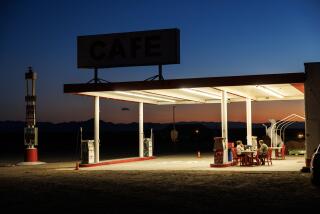The Oddities on the Road Less Traveled
- Share via
If your summer vacation plans are limited to major, well-traveled tourist attractions, you can stop reading right now.
The Web can be used to research the Grand Canyon, the Statue of Liberty or Yosemite, but info about those spots is widely available in other mediums.
If, however, you want to see the world’s largest concrete potato, a cave full of ultraviolet sculpture or an outdoor exhibit of 400 portraits painted on toilet seats, you can find out all about them at https://www.roadsideamerica.com, a site devoted to fascinating, hilarious and sometimes creepy attractions off the beaten path.
“Greetings from Roadside America,” declares the home page. “Your guide to strange and wacky vacation wonders.”
The site was created by three authors who put out a “Roadside America” guide book in 1986 and then a sequel, “The New Roadside America,” in 1992 that is still in print.
In 1994, they had their first Web experience. “We traveled around the country and issued daily reports, including video and audio,” says Doug Kirby, one of the authors, whose day job is working for AT & T’s Web site. It got them interested in starting their own Web site to contain selections from the book and be a gathering place for others of like minds to add their own finds.
At the site, you can search for attractions by state or by category, such as “Talented Animals” (mostly a guide to famous animals in pet cemeteries), “Scary Thrills” (like the cave), “Impossible Dreamers” (the toilet seat painter) and “Looming Bunyans.”
The last of those refers to large Paul Bunyan statues, which seem to have cropped up across the country in public parks, frontyards or as part of advertising tableaux. So far, the site lists 31 statues.
You can spend hours poring through the approximately 500 attractions featured on Roadside America. Some are so weird that they are probably best viewed digitally and not visited in person. But some merit, if not a special trip to the locale, at least a visit if one finds oneself within 50 miles or so.
Examples of these include the huge concrete statues made by a dentist for his own amusement (and the amusement of folks who drive by his place) in Auburn, Calif. These statues of an Amazon archer and a nude man in chains, to name just two, are as tall as 42 feet, weighing in at more than 120 tons.
Then there is the World Potato Exposition in Blackfoot, Idaho, home of not only the aforementioned concrete spud but also of a burlap tuxedo once worn by the state potato commissioner.
Kirby and his co-authors have something in common with the creators of personal roadside works of art: They do it for love. The Roadside America site, which went online last year, carries no advertisements except a small one for their current book. They hope to one day find a sponsor but keep the site afloat with their own funds.
“If you really love this stuff, you end up pouring the money you make into just traveling to see more of it anyway,” Kirby says. “The great thing about the Web is that it gives us the chance to take all this stuff we’ve been doing all these years and put it online. It has re-energized us to get back out on the road and discover more.”
*
Cyburbia’s e-mail address is david.colker@latimes.com
More to Read
Sign up for The Wild
We’ll help you find the best places to hike, bike and run, as well as the perfect silent spots for meditation and yoga.
You may occasionally receive promotional content from the Los Angeles Times.







